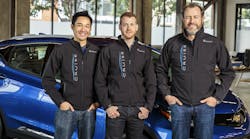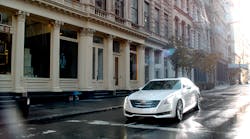As part of its aggressive plans to develop fully autonomous vehicles, General Motors said it was buying Cruise Automation, a start-up company that develops software for self-driving cars.
The deal represents GM's latest push to include more automated features in vehicles, reducing the role of humans behind the wheel. It also highlights the industry's efforts to develop vehicles that autonomously navigate city streets, avoid collisions and other accidents, and connect to street lights and other forms of infrastructure.
Founded in 2013, Cruise Automation has developed an aftermarket kit that converts existing cars into autonomous vehicles for highway driving. The company equips the vehicle with an array of computer processors and sensors, along with the software that helps the vehicle to react to the sensor data. It was designed to work with certain Audi models.
The terms of the merger have not been disclosed. Several sources familiar with the transaction have said that it was north of $1 billion in cash and stocks, according to reports from Fortune magazine. Cruise was most recently valued at $90 million after several rounds of venture capital funding had raised over $18 million.
Kyle Vogt, the chief executive of Cruise, said in a statement that gaining access to GM’s manufacturing resources was necessary to advance his company’s technology. “This is a ground-breaking and necessary step toward rapidly commercializing autonomous technology,” he said.
GM, the largest auto company in the United States, has been actively searching for engineers in robotics, computer vision, and software to pad its autonomous vehicle division. The scarcity of these engineers is fueling fierce competition between automakers and tech companies like Uber Technologies, Apple, and Google X—the search company’s offshoot working on self-driving cars. All these companies have turned to sourcing engineers from competitors and harvesting researchers from universities.
“We intend to invest significantly to further grow the talent base and capabilities already established by the Cruise team,” Mark Reuss, GM’s executive vice president of global product development, purchasing and supply chain, said in a statement. The Cruise website, which was updated to reflect the deal, is bare except for listings of GM engineering jobs, inviting applicants to “join the driverless revolution.”
The intense search for engineers underlines the strategic shift that the automotive industry has taken—and the vast sums pouring into their research projects. Toyota has set aside $1 billion for a new autonomous vehicle research division, which recently hired the entire staff of Jaybridge Robotics, a company that makes autonomous tractors and mining equipment. Ford has established an entire division focused on self-driving cars and has pledged to triple the size of its engineering team involved with autonomous vehicles.
For its part, GM has made strides to shed its image as the lumbering elephant of Detroit, getting involved with what have become known as transportation services. In January, it invested $500 million into the ride-hailing startup Lyft, saying that they would collaborate on an entire fleet of self-driving cars. GM has also purchased parts of Sidecar Technologies, a smaller competitor to Lyft and Uber, and founded a car-sharing service called Maven. In 2017, it will introduce semi-autonomous features in Cadillac models with its Super Cruise system.
With new technologies meeting an old guard of safety standards, automakers are still facing regulatory hurdles and technological challenges. While semi-autonomous cars have few remaining roadblocks, the Department of Transportation has said that it needs guidelines for more advanced designs, such as cars without steering wheels or brake pedals.
Mike Ableson, GM’s vice president of strategy and global portfolio planning, testified to the Senate Committee for Commerce, Science, and Transportation on March 15, urging Congress to remove barriers in the way of autonomous cars. This includes consolidating the patchwork of regulations that each state has taken with the technology. Chris Urmson, director of self-driving cars at Google X, and Joseph Okpaku, vice president of government relations at Lyft, also testified.
One of the points Abelson stressed during his testimony was the short-term plans for the Cruise Automation and Lyft investments. “We believe that the next logical step toward public availability of high-level automated vehicles will be controlled ride-sharing projects, such as what we are planning with Lyft,” he said.


